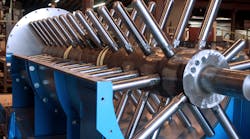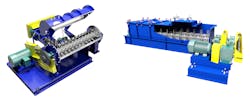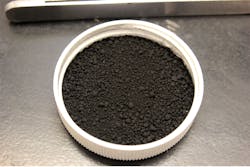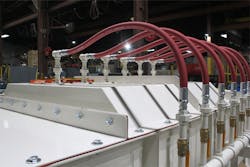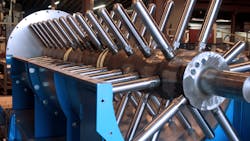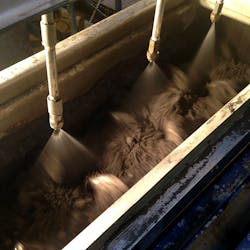“Good enough” is no longer satisfactory when it comes to solids and liquids blending. Performance issues can result in problems with product quality, maintenance and productivity. This is particularly true with continuous mixers, which many chemical processing facilities rely on to blend solid and liquid components into a homogeneous mixture.
It’s a mixing step that sets the tone for subsequent processing, meaning it holds the power to streamline or hinder production, while also influencing end product quality and uniformity. As such, optimizing this step is critical for blending product to specification and doing so efficiently. The following covers fundamental but often-overlooked ways to improve the blending process in pin and pugmill mixers (Figure 1).
Note: While this article refers specifically to pin mixers and pugmill mixers, the principles of effective mixing extend beyond the type of mixer used.
Pin and Pugmill Mixer Capabilities
The need to homogeneously combine solid and liquid feed components spans nearly every industry that handles bulk solids, starting with raw-material processing and ending with complex chemical production.
To accomplish the diverse objectives of these applications, many manufacturers rely on pin mixers and pugmill mixers — two horizontal continuous mixers with extensive capabilities in blending. While some overlap exists in their capabilities, each has its own strengths.
A pin mixer consists of a shingle shaft fitted with rods (“pins”), which rotates inside a stationary cylindrical trough. This centrifugal rotation imparts a powerful spinning action on the material, which not only thoroughly blends the solid and liquid components but can also be used to cause rapid densification and agglomeration of the material.In contrast to the intense spinning motion employed by the pin mixer, the pugmill mixer applies a gentler folding and kneading motion, delivered through dual counter-rotating shafts fitted with paddles (for this reason the mixer is also commonly referred to as a paddle mixer).
Both mixers are highly adept at homogeneous blending, but the different action used by each can be either an advantage or a disadvantage, depending on the material characteristics and the specific objective(s) at hand.
Finding the Right Balance
Material characteristics have a major influence on the most appropriate blending action and the type of mixer chosen.
Material consistency. The high-speed spinning action imparted by the pin mixer is better suited to free-flowing materials, as sticky materials would bog down the mixer, making it less effective and putting additional strain on the mechanical components. Similarly, while additional wear resistance can be built into a pin mixer, the intense spinning action can encourage excessive wear when coupled with an abrasive material.
Conversely, the gentle, high-torque action of the pugmill mixer is highly effective at working through sticky or sludge-like materials and is less susceptible to wear when the material being blended is abrasive.
Particle size distribution. The particle size distribution of feedstock is also an important factor to consider in choosing between these two mixer types. Pin mixers perform better with smaller particle size ranges, as larger chunks could become lodged between pin tips and the trough interior.
Pugmill mixers have more clearance between components and can therefore handle larger particle sizes. Similarly, while the potential for tramp material to enter the mixer should always be minimized, the high torque associated with the pugmill mixer is better suited to displace any materials that might become lodged, whereas the pin mixer could experience significant damage.
Throughput. Pugmill mixers also have a much higher throughput than pin mixers, so in situations where either mixer will suit the process, producers may choose to go with the pugmill for this reason.
Blending and densification. Both mixer types yield a homogeneous blend, but pin mixers are the preferred choice when densification is the goal, particularly when it comes to ultra-fine materials like carbon black (Figure 2).Ultimately, mixer selection rests on finding the right balance between process and product goals and the characteristics of the material. Pin mixers tend to be selected for blending and densifying ultra-fine materials, as well as creating smaller agglomerates, while pugmill mixers are better in tougher applications that benefit from the high torque and kneading action.
Improving the Blending Process
No matter what type of mixer a processing plant chooses, there are several overarching principles that can help manufacturers optimize the blending process for efficiency and product quality based on their specific requirements. The following 10 techniques are generally applicable in most settings.
1. Optimize the Spray System
The mixer’s spray system design plays an integral role in overall blending effectiveness. The number and location of spray ports, along with the nozzle types, spray pressure, height above material bed, and feed rate of the liquid component significantly influences particle wetting and the uniformity of a mixture.
It is ideal to incorporate multiple liquid injection ports (Figure 3) into the spray system design, as a wider distribution of liquid promotes more uniform blending compared to a localized or concentrated spray. Incorporating multiple injection ports, even if not all are used, also is beneficial in that it enhances operator control over liquid addition during the start-up process or in the event of changes in feedstock or process conditions.It’s important to design the spray system according to product goals and the unique specifications of the material feedstock. Different materials, as well as the same material from different sources, may exhibit variations in chemical and physical composition, causing them to respond uniquely to wetting and requiring a tailored approach.
Chemical facility operators also should customize the spray system based on how the mixture changes as it moves through the mixer; this may require nozzle type or liquid feed rate to change along the length of the mixer as well.
In some cases, it may be appropriate to locate most of the spray ports toward the feed end, adding most of the moisture near the inlet. In other cases, it may be more appropriate to spread out the spray ports along the length of the mixer for the addition of moisture in smaller increments.
2. Maintain a Consistent Feed
Maintaining a consistent feed seems obvious, but it is often the cause of many headaches, with even slight changes in moisture content, particle size distribution or chemical composition having the potential to throw a process off balance. This can result in over- or undermixed material, undesirable agglomerates or even process upset.
As such, carefully managing feedstock uniformity is an essential aspect of optimizing the blending process; the more uniform the material going into the mixer, the more uniform the product exiting the mixer will be and the more stable the process will be.
Managing feedstock uniformity through implementing necessary pretreatments or even changing raw-material vendors should be a top priority for those intent on optimizing their blending process.
3. Optimize Pin/Paddle Arrangement
It’s possible to engineer both pin mixers and pugmill mixers, as well as other mixer types, to adapt the agitation methods for changes in process conditions. In the case of pugmill mixers, for example, paddle arrangement, the number of paddles and the angle at which they are positioned, are adjustable.
In cases where the feed material varies in particle-size distribution or contains lumps, it’s possible to adjust the unit to break up lumps for more effective mixing. In this setting, the operator can adjust the paddle angle to be closer to a vertical position to create a chopping motion. This can help break up lumps formed when moisture is added.
Also, operators may find they can achieve better results with small adjustments to the pattern arrangement, allowing them to manipulate material flow within the mixer, affecting the mixing action and in some cases retention time.4. Minimize Buildup
Buildup is one of the most common and yet most easily prevented causes of issues and inconsistencies in the blending process.
Buildup can encourage accelerated corrosive or abrasive wear in mixers, which affects equipment performance and longevity, as well as process efficiency. Further, excessive buildup has the potential to break away and damage production equipment. The longer material is allowed to build up, the greater the risk to both process and equipment.
Not surprisingly, buildup can also result in contaminated or off-spec material. As such, plant managers should implement protocols for mixer cleaning as the production schedule allows to minimize buildup.
In more extreme cases, further measures may be taken to prevent buildup altogether. This might include incorporating non-stick liners and chutes, the use of alternative materials of construction, or even feedstock pretreatment.
5. Automate
Automation is a powerful tool in streamlining process and equipment efficiency, resulting in an increasing number of mixer manufacturers offering automation systems as part of their capabilities.
Automation for continuous mixers ranges from simple start-up and shutdown assistance to advanced data tracking, trending and real-time time adjustment to prevent process upsets.
These systems give operators enhanced control over the mixing process, allowing them to respond in real time to process or feedstock fluctuations, optimize the process for enhanced efficiency and circumvent potential issues by monitoring key performance indicators (KPIs).
With tracking and trending capabilities, automation systems also can give plant managers a more transparent view of their process equipment and overall production efficiency. This provides invaluable benchmarking data and opportunities for maintenance planning.
6. Incorporate a Variable Frequency Drive
Some types of mixers benefit from the incorporation of a variable frequency drive, or VFD, a more flexible alternative to fixed-speed motors that gives operators more control in starting up and shutting down the process, as well as fine-tuning product quality.
A VFD allows for the operator to control motor speed to respond to changes in production, or to streamline start-up and shutdown. Because of this, the use of a VFD also helps to reduce stress on mechanical components.
7. Customize Materials of Construction
While most people think of materials of construction when it comes to new equipment, it may be possible to replace sections and components of an existing mixer to achieve more effective blending. This may be to reduce buildup and promote greater flowability or simply to reduce wear on the equipment.
Similarly, plant managers may be able to take advantage of trough liners, alternative pin/paddle materials and facings, and other modifications to the materials of construction for improved functionality and longevity.
8. Reevaluate the Process
The struggle to maintain, or even reach rated capacity can be a complex endeavor. When operators can’t reach production goals after troubleshooting and adjustment it may be time to reevaluate the process.
In some cases, the mixer simply may not be the most suitable option for the task at hand. In other cases, a fluctuation in feedstock characteristics may be to blame. Pinpointing the origin of an issue can be a major challenge and oftentimes requires outside expertise.
While direction and objectives may seem unclear beyond simply improving the process or resolving an issue, plant managers have several resources at their disposal.
9. Consider a Process Audit
The particulars of a process audit vary based on the provider, but in general, a process audit consists of an expert coming in and systematically evaluating the process. The auditor considers many factors, including original process design, feedstock parameters and production goals.
10. Opt for Testing
Testing with an in-house R&D department (Figure 5), rental equipment or a dedicated third-party testing facility can help establish a baseline for the process, evaluate different mixer types and assess changes in process and equipment adjustments, all without affecting the live production environment.
Ensure Operators Have the Tools They Need
While mixing is a relatively straightforward objective in theory, there are many opportunities for problems to arise, particularly when efficiency or product quality are top priorities; even a slight deviation in specification is often unacceptable in many cases.
One way to keep production moving smoothly is to ensure operators have the knowledge and tools they need to be able to respond accordingly to any issues. This means thoroughly training operators on mixer operating principles and the specific challenges associated with the material being processed and the goals at hand.It also could take the form of a readily accessible troubleshooting matrix, which lays out the problems alongside their potential causes and adjustments to make in order of priority. For these reasons, it’s important to have a good working relationship with the mixer OEM for consultation, when necessary.
The Path Forward
The ability to blend materials into homogeneous mixtures is a cornerstone of modern chemical production that spans across nearly every sub-sector. With efficiency and product quality central to most operations, optimizing this mixing process is vital to meeting both process and product goals.
Plant managers and operators have many opportunities to maximize this aspect of production at their disposal, no matter what type of mixer they are working with. Optimizing spray system design, maintaining feedstock uniformity and taking advantage of automation technology are just a few of the options available to them, with the potential for small changes to have a major impact.
In settings where the path forward is unclear, plant managers can opt for a process audit or testing services to provide guidance.
